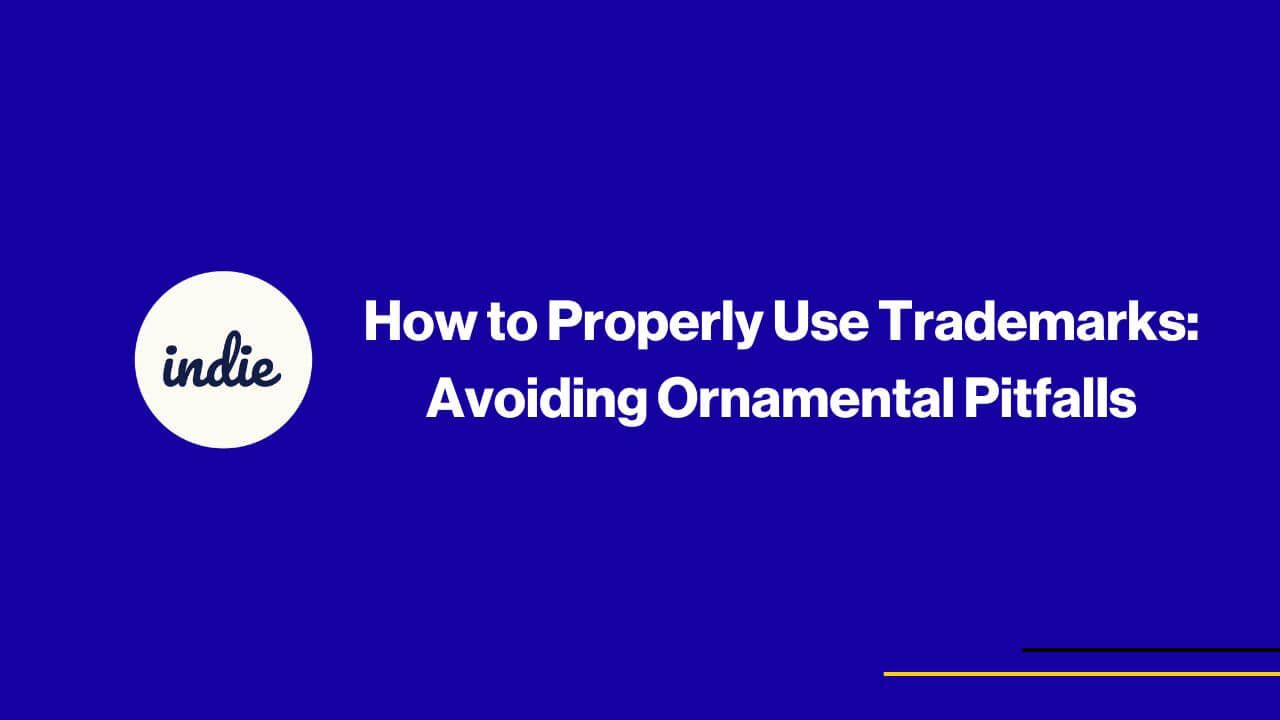Table of Contents
- Introduction
- What Is Ornamental Use?
- Why It Matters
- Distinguishing Ornamental from Trademark Use
- How to Protect Your Mark
- Legal Risks of Ornamental Use
- Conclusion
When it comes to trademarks, the distinction between what can be legally protected and what cannot often creates confusion. A key area where this confusion arises is with designs, phrases, or logos that are used ornamentally. The question isn’t how to trademark something ornamental, but how to ensure your use qualifies as trademark use and not just decoration.
In this guide, we’ll break down:
- What ornamental use means
- Why it matters
- How to position your mark as a source identifier
Whether you’re a business owner, designer, or entrepreneur, this post will help you navigate the nuances of trademark use.
What Is Ornamental Use?
Ornamental use refers to designs, phrases, or symbols used purely for decorative purposes on goods like clothing, accessories, or merchandise. Unlike trademarks, which serve to identify the source of goods or services, ornamental designs do not function as brand identifiers.
Examples of Ornamental Use:
- A t-shirt with “Stay Positive” printed prominently across the chest is ornamental.
- A small logo on the tag or neckline of the same shirt identifying the brand is non-ornamental and qualifies as trademark use.
The U.S. Patent and Trademark Office (USPTO) often denies trademark applications for designs or phrases that are seen as purely ornamental because they lack the distinctiveness necessary to function as a trademark.
Why Does This Distinction Matter?
When a design or phrase is considered ornamental:
- It cannot qualify as a trademark. Without functioning as a source identifier, it won’t receive legal protection.
- It cannot stop others from using similar designs or phrases. If your use is purely decorative, competitors can replicate it without infringing on your rights.
For brand owners and entrepreneurs, this distinction is critical for protecting your intellectual property and avoiding legal challenges.
How to Distinguish Between Ornamental and Trademark Use
To ensure your mark qualifies for trademark protection, focus on how it is used in commerce. Here are key considerations:
1. Placement and Context
- Place your design or phrase where consumers expect to see brand identifiers, such as product tags, labels, or packaging.
- Avoid prominent placements that make the mark look purely decorative, like large prints across the front of a t-shirt.
2. Focus on Source-Identifying Use
- Use the design or phrase consistently in ways that directly tie it to your business. For example, include it in advertisements, product listings, or on your website to reinforce its connection to your brand.
- A mark must function as a signal to consumers that the product originates from a specific source, not just serve an aesthetic purpose.
3. Build Consistency Across Products
- Use the mark on multiple products and in varied contexts (e.g., clothing tags, packaging, and promotional materials).
- Consistent use reinforces its role as a trademark rather than decoration.
How to Use and Protect Your Mark
If you want to protect a design or phrase that might be seen as ornamental, here’s how to position it for trademark eligibility:
1. Incorporate It Into Packaging, Labels, or Tags
- Place the design or phrase on product labels, hang tags, or packaging to show it functions as a brand identifier.
2. Ensure It’s Used as a Trademark
- Even if a design is used decoratively, it must also appear in contexts that clearly identify your business as the source of the goods. For example:
- Include the design on marketing materials.
- Use it alongside non-decorative elements, like your business name or logo.
3. Avoid Misinterpretation of the Supplemental Register
- If your mark initially lacks distinctiveness (e.g., it’s descriptive), the Supplemental Register can provide limited protection while you build recognition. However, this is not a solution for marks used purely ornamentally. To qualify for either register, your use must still be a source identifier.
4. Document Your Use
- Provide evidence showing the design’s connection to your brand, such as:
- Product photos with the design used on tags or packaging.
- Marketing materials demonstrating consistent branding.
- Sales data or customer feedback that ties the design to your business.
Legal Risks of Ornamental Use
Using a design purely as ornamentation has several risks:
1. No Exclusive Rights
- Others can legally copy and use the same or similar designs without infringing on your rights.
2. Difficulty Enforcing IP Claims
- Attempts to enforce trademark rights over a decorative design can lead to costly legal battles.
To avoid these risks, focus on proper trademark use from the start.
Tips for Avoiding Common Trademark Pitfalls
1. Conduct a Thorough Trademark Search
- Before using a design, search the USPTO’s TESS database to ensure your desired mark isn’t already registered or in use.
2. Seek Legal Guidance
- A trademark attorney can help you determine the best strategy for using and registering your mark.
3. Focus on Brand Development
- Build consumer recognition through consistent use of your mark as a source identifier across all branding elements.
Conclusion
Understanding the difference between ornamental and trademark use is essential for protecting your intellectual property. Designs or phrases used purely as decoration don’t qualify for trademark protection. However, with strategic placement and consistent use, you can establish your mark as a source identifier and secure the rights necessary to protect your brand.

